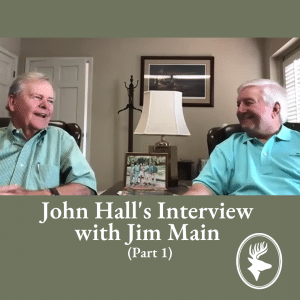Step into the world of Alabama Land Management “Part 2” of my interview with Jim Main. In this insightful interview, my friend Jim and I explore the nuances of effective land management practices, stewardship, and conservation.
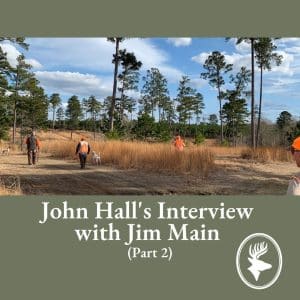
Wildlife and Land Management in Alabama
John: Let’s dive into the topic of wildlife and land management and start with deer management. We have an excess of does on our family property. This has been the case for the past several years. We’ve encountered a unique challenge with a couple of hundred acres we leased to a cotton farmer. Deer have been nibbling on the cotton stalk at its tender stage, around four to six inches tall. Unfortunately, this has significantly impacted the farmer’s cotton crop, leading to financial losses over the past few years.
Consequently, we’ve implemented a deer management program that requires us to harvest a certain number of does annually. Additionally, we’re facing a wild hog issue, for which we’ve obtained permits to control the population by shooting them at night, except during deer season.
Upon touring your property, I didn’t notice a severe hog problem. I’m curious about your land management practices and whether you’re contending with an excessive deer and hog population.
Jim: For the initial 15 to 20 years, we focused on harvesting a specific number of does each year. We maintain a sign-in book that logs the areas where you intend to go hunting. In particular, you’re required not only to sign out but also to document your observations.
During hunting season, you’ll likely encounter the same deer repeatedly. However, the data collected consistently reflects the health of our doe herd. There are two large neighboring plantations across from me, totaling around 25,000 acres.
I eventually stopped the practice of data collection as those surrounding lands weren’t contributing to deer harvesting efforts. It became evident that our management efforts were in vain. Over the years, maintaining a consistent number of hunters and hunting days has led to a stable doe herd.
Hog Issues
As for feral hogs, our game cameras capture their movement across the property. Land management is essential in controlling the wild hog population. In the low areas, we try to keep the underbrush controlled to discourage hog activity while maintaining the upland-thinned pine areas. Hogs tend to avoid open spaces. Given your substantial creek, you might face a distinct challenge, as hogs tend to travel along the creek.
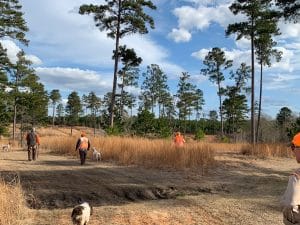
Wild Quail and Conservation Efforts
John: Your region seems to boast a healthy quail population.
Jim: Indeed, we have a population of wild quail. Around 15 years ago, we created a 35-acre “put and take” area for quail. It’s the sole place we hunt quail.
We enjoy the wild quail on our property. I was sitting on the porch at the farm with my wife and dog the other day when the quail started bob whiting. Gale would whistle back to the quail. The dog would bark whenever the quail whistled back at her, but when she whistled, the dog would not bark.
There was an entertaining show going on between Gale, the dogs, and the quail.
John: Your quail population is impressive, considering wild quail populations are diminishing. Regrettably, we don’t have any wild quail on our property, and it’s disappointing for us as we’re fond of quail hunting. We partake in “put and take” practices, releasing birds for hunting, which is enjoyable. Nonetheless, it doesn’t compare to the past, when we could find 15 to 20 coveys daily. Those days are long gone, especially since the 1960s. The decline in quail populations is disheartening.
Moving on to land management, your fish ponds are remarkable. However, it’s essential to maintain a balanced fish population by fishing 30 pounds of bass per acre annually. How do you manage that process?
Jim: We collaborate with a fish company that fertilizes and maintains our ponds. There are three ponds: a 15-acre bass and bluegill pond, a smaller catfish pond, and a five-acre “trash” pond. We refer to the latter as the trash pond because we don’t actively manage it. It hasn’t been fertilized or stocked, except for the occasional fish transfer from other ponds. The farm workers enjoy fishing in the trash pond, as it harbors the largest fish. Our fish management team might not endorse this approach.
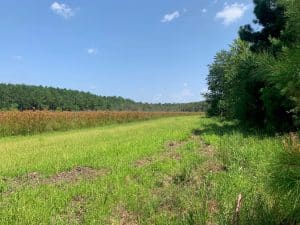
Alabama Land Management of a Duck Project
John: Can you elaborate on your duck project?
Jim: When we acquired the property, it included a 35-acre duck project initiated with federal funding by the previous owners. The project mandates maintaining it as a duck project for ten years due to Federal commitments. It’s a truly distinctive feature of the property.
John: Your duck pond is remarkable. I understand you drain and plant duck food, flooding it during the winter. Despite not being on the flyway, you attract a substantial duck population.
Jim: We primarily attract wood ducks and occasionally other ducks. Over the years, cold fronts have pushed ducks our way, resulting in a sudden influx of around 100 to 300 ducks for about eight to ten days. They then move on when the next cold front arrives. We limit duck hunting to mornings to avoid disrupting nesting patterns. Consequently, we only hunt ducks two to three times annually to prevent over-pressuring the population.
John: That’s a special, unique part of your property because most people don’t have ducks. They are so beautiful to watch, and you can watch them from the porch of your lodge.
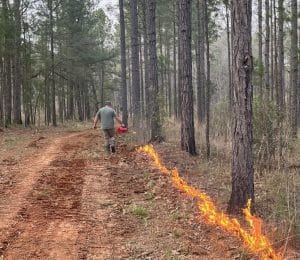
Alabama Timberland Management
John: Land management is an ongoing process. Let’s delve into timber management. I’ve noticed controlled burns on your property. This practice is essential to maintain pine timber stands and control undergrowth, benefiting both timber and wildlife. Do you perform controlled burns annually or biannually?
Jim: We conduct controlled burns on half of the pine acreage yearly. We mow the fields with a bushhog, and the hardwoods are excluded from burning. Small tracts of 40 acres or less are divided into burn zones, refreshed twice annually in spring and fall. We alternate burning the northern and southern halves each year. With 10 to 40-acre burn zones, we can manage the burns ourselves with just two people and equipment.
Because it’s small enough tract, the fire won’t get out of hand. But if you burn over 300 acres and set it on fire, you better have the Forestry Commission or a certified burner on the property.
John: Yes, that’s another thing John Hall and Company offers! We’ve got a registered Forester on our staff.
Hayden Nichols is a land broker and registered forester who manages timberland for private landowners. An Auburn graduate, he is very knowledgeable about timber and timber management. As you can imagine, he is a great asset for John Hall and Company as he helps us and the property owner assess the timber value of a potential new land listing.
Closing Thoughts from John Hall
I’m grateful for you joining us and sharing insights on your journey into wildlife and land management. It is my hope that our conversation has shed light on the delicate balance required for effective land management. From deer populations, quail habitats, fish ponds, and controlled burns, your experiences and strategies offer a glimpse into the challenges and satisfaction for people who are considering buying recreational property in Alabama.
More John Hall and Jim Main Interview
We will post the third and final part of this series next week. In Part 3, Jim shares some of his favorite memories on the farm with family and friends, and one memory involves a former governor. You will definitely want to read Part 3 next week. For now, if you missed Part 1, click the photo or link below to read more.
Read Part 1 of my interview with Jim Main here-
Part 1: Investment Property in Alabama: Jim Main’s 30-Year Journey

